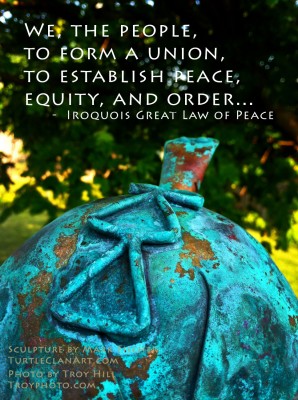I had a fun time, as usual, at the Eiteljorg’s Indian Market and Festival. I’ve always admired the sculpture work of Mark Fischer, who does a lot with Turtles.
Turns out, he’s from the Oneida Nation of Green Bay, Turtle Clan.
 You can find more of his wonderful work here: http://turtleclanart.com
You can find more of his wonderful work here: http://turtleclanart.com
This sculpture carries the sign of the Tree of Peace:
The wampum belt pattern within this sculpture is called the Wing or Dust Fan and represents the everlasting tree of peace. It symbolizes the permanence of The Iroquois Confederacy. It is said to be a great white pine tree, and was planted when the Peacemaker came to visit our people and bring the good message of peace, power, and righteousness. Under the white roots, which spread in all four directions, all the weapons of our people were buried for purposes of creating an everlasting peace.
More on the Iroquois Great Law, and how it had an influence on the framers of the US Constitution can be found here:
Historians, including Donald Grinde of the University at Buffalo, The State University of New York, have claimed that the democratic ideals of the Gayanashagowa provided a significant inspiration to Benjamin Franklin, James Madison and other framers of the United States Constitution. Franklin circulated copies of the proceedings of the 1744 Treaty of Lancaster among his fellow colonists; at the close of this document, the Iroquois leaders offer to impart instruction in their democratic methods of government to the English. John Rutledge of South Carolina, delegate to the Constitutional Convention, is said to have read lengthy tracts of Iroquoian law to the other framers, beginning with the words “We, the people, to form a union, to establish peace, equity, and order…”[2] In October 1988, the U.S. Congress passed Concurrent Resolution 331 to recognize the influence of the Iroquois Constitution upon the American Constitution and Bill of Rights.[3]